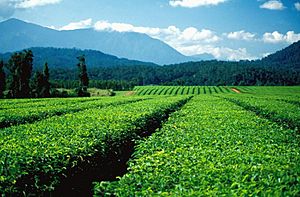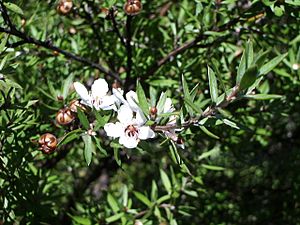Tea in Australia facts for kids
Did you know that drinking tea is a big part of Australian culture? Australians learned to love tea from the British. But they have also added their own special touches to tea drinking. Australia even grows a small amount of its own tea!
Contents
The History of Tea in Australia
Long ago, before Europeans arrived, Aboriginal Australians drank a special drink. They made it from a plant called leptospermum. This plant is different from the tea plant we know today. It's also called the "tea tree."
When Captain Cook first landed in Australia, he saw Aboriginal people drinking this plant infusion. He called it "tea." That's how the plant got its nickname, "tea tree."
Tea Arrives with the British
When the British came to Australia, they brought their love for tea with them. In fact, tea was on the First Fleet of ships that arrived in 1788! Because of this, tea became a huge part of Australian life. Australians enjoy "afternoon tea" and "morning tea" just like people in Britain.
Australia's warm climate, especially in the north, is also good for growing tea plants. This means Australia can produce its own tea.
First Tea Businesses in Australia
In 1883, a man named Alfred Bushell opened Australia's first tea shop. It was in what is now Queensland. The very next year, in 1884, the Cutten brothers started Australia's first commercial tea farm. This farm was in Bingil Bay, in northern Queensland.
Later, in 1899, Alfred Bushell's sons moved their tea business to Sydney. They started selling tea to many people. This was the beginning of Bushell's Company, Australia's first big tea seller.
Modern Tea Farms in Australia
In 1958, Dr. Allan Maruff began planting tea again in Australia. He used seeds from the old Cutten brother's farm. His new farm was in the Nerada valley, south of Cairns, Queensland.
Then, in 1969, another company called Tea Estates of Australia (TEA) started growing tea next to the Nerada farm. In 1971, Nerada Tea Estates (NTE) opened Australia's first modern tea factory. TEA later bought NTE and started selling tea under the "Nerada" name.
Nerada Tea is now the biggest grower of Australian tea. They have over 400 acres of tea plants near Cairns. They produce about 1,500,000 kilograms of black tea each year!
Another important tea farm is Madura tea estate. It was started in 1978 by Mike and Norma Grant-Cook. They were tea growers from Sri Lanka. Their farm is in Murwillumbah, in New South Wales. Madura produces different types of tea, like Assam tea and green tea.
Other tea producers in Australia include the Byron Bay Tea Company, the Red Sparrow Tea Company, the Daintree Tea Company, the Tinbeerwah Tea Company, and the Two Rivers Green Tea Company.
Australian Tea Culture
Australian tea culture is quite similar to British tea culture. When you visit someone's home, they will often offer you a cup of tea. It's also common to have small snacks during "morning tea" and "afternoon tea." Sometimes, the main evening meal is even called "tea"!
As more people from Asian countries live in Australia, Australian tea culture is also changing. It's mixing with tea traditions from places like Japan, China, Taiwan, India, and Sri Lanka. Many tea shops in Australia, like T2, now sell teas from Asia.
Tea and the Australian Economy
In 2000, Australians drank about 14,000 tonnes of tea every year. Most of the tea grown in Australia is black tea. However, a small amount of green tea is also produced in the Alpine Valleys area of Victoria. Australian tea farms are mostly found in northern New South Wales and Queensland.




